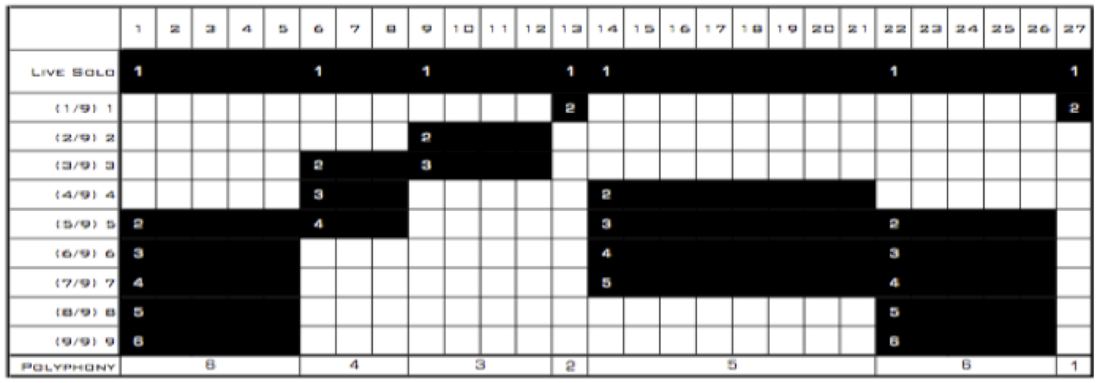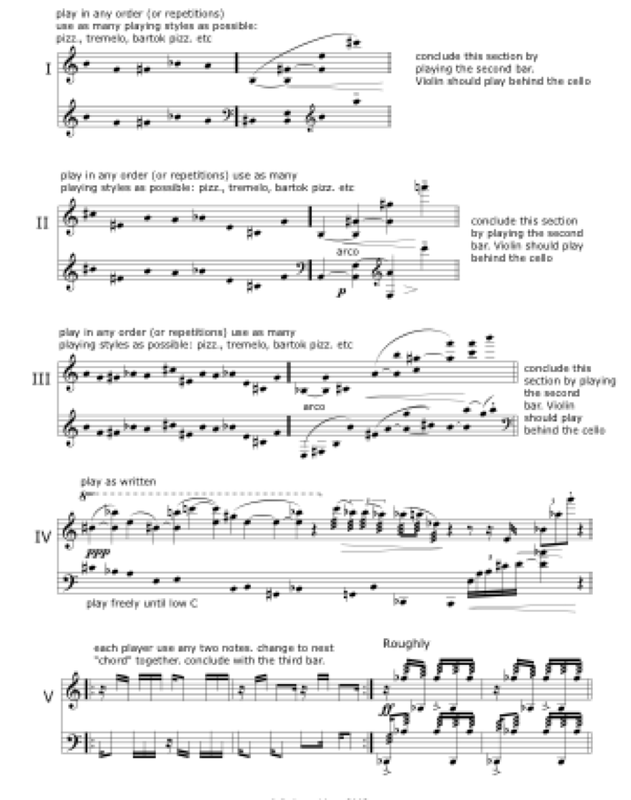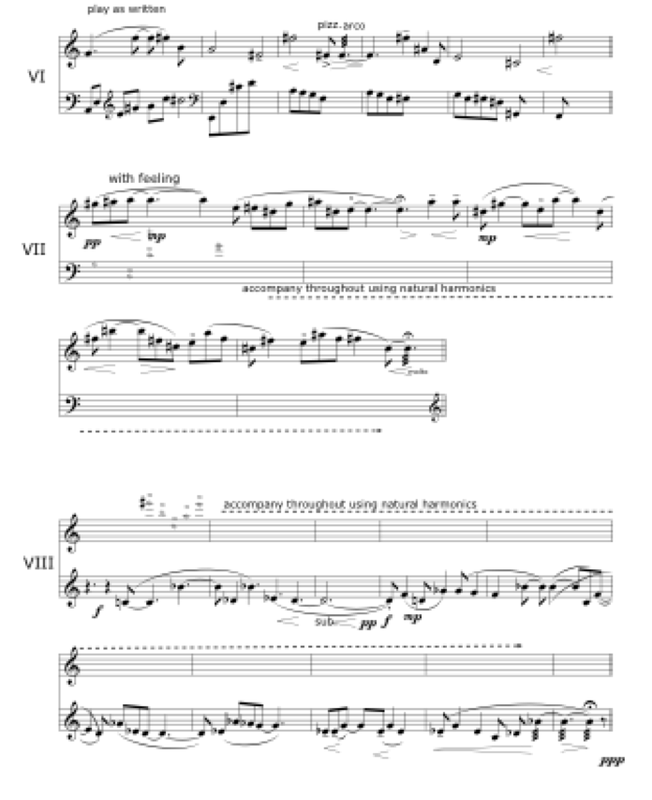67 The Bread Trap 2001 voices, saxophone, clarinet, accordion and bouzouki
66 Perfunktory Stain (for the Dance work by Catherine Puie and Lucy Taylor) with Petro Vouris 2001 CD
66 Perfunktory Stain (for the Dance work by Catherine Puie and Lucy Taylor) with Petro Vouris 2001 CD
65 delicious ironies (series 1) 2001 solo improviser(s) and live electronics or CD 7m
|
Delicious Ironies was created as a vehicle to provide an extremely unpredictable and provocative sonic environment for the solo improviser. The intention was to use sound samples that were pertinent to the soloist, but also volatile and erratic enough to inspire an interesting improvised response in the moment.
|
The stream of samples that accompany the improvisor in Delicious Ironies is created by nine layers of event-generating objects. The fastest object sends cues at nine times the speed of the slowest (See Figure to the right). Events sent from the objects are mapped to different aspects of sample playback: i.e. sample choice, playback speed, duration, volume, loop, pan and portamento amount.
|
Despite the fact that the events are ‘played’ by the computer in exactly the same temporal framework each time, the altered sample set generates an utterly different sounding piece each time. The computer's utterances act to prompt the live soloist and, in the best circumstances, the two form an amalgam in performance. However, despite it sometimes sounding to the contrary, the performer cannot influence the computer performance in any way.
|
In order to shape a formal structure from the continuous polytemporal cuing, not all of the nine event generating objects are activated at all times. The changes in activation patterns follow the “cypher” pattern discussed in the previous section. At the beginning five layers are active, followed by 3, 2, 2, 1, 4, 4, 5, and then 1 layer with the length of activation time proportional to the number of active layers. (For example the section with five active layers is five times longer than the section with one active layer) (See Figure above).
|
|
|
The changes in texture generated by these activation patterns are the principal means of creating disjunction between substructures in the work. In this sense the Delicious Ironies series works are all “cypher works” with the same formal divisions as the works discussed under the heading “Block Form”.
There are three “series” of Delicious Ironies works:
· Series one: for sampler cued via MIDI from a computer running Max/MSP
· Series two: for a computer running Max/MSP accessing samples on its hard-disk
· Series three: for a computer running Max/MSP accessing samples on its hard-disk, and processing the sounds of the samples and of the performer.
Series one focused on narratively related samples, for example, from film noir, boxing movies and record glitches. Series two did not provide any score and used samples derived from extended techniques made by the performers themselves: for example guitar and Sichuan opera percussion instruments. Series three explored the deconstruction of my own pieces Kreuz des Suedens, Cyphers of the Obscure Gods with the addition of a mobile score, improvisations by my group shmil, the work of others: Earle Brown’s December 1952 and improvisations by bassist Dr. Ian Woo.
In Delicious Ironies a sense of immanence in the performer is encouraged by specifically instructing that the performers to not listen to the computer component prior to the performance. Series one and three of provide a mobile score as an additional source of stimulus for the performer. In Delicious Ironies (noir), the source of the text was taken from a pre-existing dance-theatre work of mine noir (2000). The text was constructed by dividing the page into four columns and then flowing the words vertically around the columns. The performer, reading the text in the traditional left to right manner, is presented with a “cut-up” version of the text from noir. In regard to interpretation of the mobile score, the performance instructions state,
There are three “series” of Delicious Ironies works:
· Series one: for sampler cued via MIDI from a computer running Max/MSP
· Series two: for a computer running Max/MSP accessing samples on its hard-disk
· Series three: for a computer running Max/MSP accessing samples on its hard-disk, and processing the sounds of the samples and of the performer.
Series one focused on narratively related samples, for example, from film noir, boxing movies and record glitches. Series two did not provide any score and used samples derived from extended techniques made by the performers themselves: for example guitar and Sichuan opera percussion instruments. Series three explored the deconstruction of my own pieces Kreuz des Suedens, Cyphers of the Obscure Gods with the addition of a mobile score, improvisations by my group shmil, the work of others: Earle Brown’s December 1952 and improvisations by bassist Dr. Ian Woo.
In Delicious Ironies a sense of immanence in the performer is encouraged by specifically instructing that the performers to not listen to the computer component prior to the performance. Series one and three of provide a mobile score as an additional source of stimulus for the performer. In Delicious Ironies (noir), the source of the text was taken from a pre-existing dance-theatre work of mine noir (2000). The text was constructed by dividing the page into four columns and then flowing the words vertically around the columns. The performer, reading the text in the traditional left to right manner, is presented with a “cut-up” version of the text from noir. In regard to interpretation of the mobile score, the performance instructions state,
|
|
The example in to the right shows the order in which the text was performed by Melissa Madden Gray in the opening of the recording of Delicious Ironies (noir). She chose to begin the work reading left to right sequentially across the two pages of text, alternating between taking one or two vertical lines at a time and sometimes overlapping the text by reading lines that were spoken in a different context in the previous pass: for example “the stake-out They say” in the first pass and “They say there’s some” in the second pass. Similarly, in the work Delicious Ironies (KDS), the performers are presented with a notated mobile score, this time comprising deconstructed elements of my work Kreuz des Suedens as shown to the left. In performance, the violin and cello players signal each other to indicate a transition to another of the eight possible fragments. The electronic component of the work is analogously comprised of samples from a performance of the linear version of Kreuz des Suedens, that are assembled in performance by the computer.
Listen here. |
64 Communication Breakdown 2001 saxophone and electronics 6m
This little ditty commemorates the unsuccessful (due to my flat battery) attempt of Hungarian Industrial Noise expert Csaba Toth to arrange a meeting late one night last week. This work was performed on 24 July 2001 and subsequently entirely lost.
63 whythisandnotanother? 2001 voice, bass, piano and sampler 11m
|
whythisandnotanother? began as the first of my three very short novels: The 'novels' were all created by creating cut-ups of texts describing vivid life events with the idea that the elements of such events somehow remain resistant to decontextualisation. The 'novels' take the form of 10 or so small blocks of these compressed texts exploring obsessive memories. The implication being that like the descriptions of dream that always seem to be disproportionately large these telegraphic collections of words would somehow signifying a much larger (and essentially indescribable) set of events. A live version was created in 2000 involving the recitation of the work’s ten ‘chapters’ to create a structure around which three musician's improvise according to certain rules specifying pitch set sizes, timbres and textures. A film version shot and edited by Tanja Visosevic and myself was created in 2001 and adds a third layer to the work - the long empty shots of the interior of a house - contextualizing the disembodied narrator. In 2002 another version of the work used the film with the narration as a Score-film to be performed with three musicians improvising using the original musical 'rules'.
Listen here. |
|






